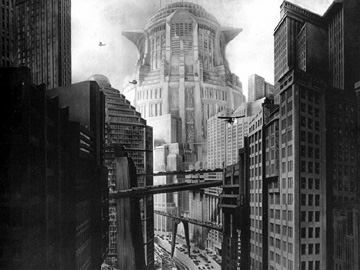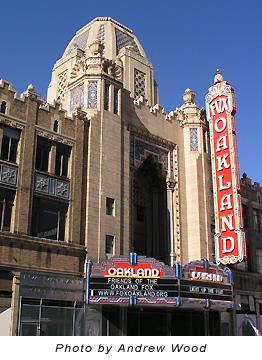
Office: HGH 210; phone: (408) 924-5378
Email: wooda@email.sjsu.edu
Web: http://www.sjsu.edu/faculty/wooda
 |
Dr. Andrew Wood Office: HGH 210; phone: (408) 924-5378 Email: wooda@email.sjsu.edu Web: http://www.sjsu.edu/faculty/wooda |
Bruno, G. (1997). Site-seeing: Architecture and the moving image. Wide Angle, 19(4), 8-24. Available from Project MUSE.
Note: These comments are not designed to "summarize" the reading. Rather, they are available to highlight key ideas that will emerge in our classroom discussion. As always, it's best to read the original text to gain full value from the course.
 Giuliana
Bruno’s essay offers a complex (and potentially frustrating) encounter
with film. In this piece, she proposes that cinema works at a level beyond mere
pleasure, that it has taught us the values of modernity. Aided by movies, we
are freed to see the city in seemingly impossible ways. Doing so, we might rethink
our notions of self.
Giuliana
Bruno’s essay offers a complex (and potentially frustrating) encounter
with film. In this piece, she proposes that cinema works at a level beyond mere
pleasure, that it has taught us the values of modernity. Aided by movies, we
are freed to see the city in seemingly impossible ways. Doing so, we might rethink
our notions of self.
To begin, Bruno argues that nineteenth century architecture helped lay the foundation
for twentieth century film. To advance this argument, she describes architectural
sites of transit such as the arcade (a predecessor to contemporary shopping
malls), the railway, and the exhibition space, sites that were built around
movement rather than stasis. Here, she refers to the notion of flânerie,
the nomadic gaze that some scholars compare to contemporary wandering through
a mall. Early on, she sets up the idea that nineteenth century architecture
revealed the potential for anyone to roam, even women who might otherwise be
locked into enclosed domestic spaces.
Bruno then shifts her attention to the movie “house” as a smaller
version (a mise en abîme) of the whole city, adding that panoramic
films could further transform the movie house into a miniature of the entire
world. With this claim, she proposes that movie houses and the films they show
offer the best way to understand modernity. Indeed, cinematic versions of the
city in films such as Metropolis (image above) and The Crowd
might offer more “realistic” views of the experience of urbanity
than the “real thing.” She writes: “The movie theatre housed
the city, which was itself a movie house, a theatre of modernity’s journeys”
(p. 13). At this point, Bruno focuses a bit on the architecture of movie
“palaces” as sites for tourism.
 Initially,
Bruno describes movie palaces as sites that provided impossible conflations
of distinct geographies, such as the Hindu-Islamic architecture found in the
Oakland Fox Theatre (image left). Moreover, inside the movie theatre, one becomes
a tourist to perpetually changing scenes. Even seeing the same movie, one encounters
differently from every location. “One never sees the same film twice”
(p. 13). And, of course, the films themselves are montages of multiple views
and “paths” that create a sense of order that, nonetheless, may
be encountered from the freed perspective of the tourist. This is what Bruno
means when she refers to “promenade architecture”: both the city
and the cinema must be experienced on the move. Taken together -- the theatre,
one’s position within it, and the nature of film itself -- creates a libratory
city in which one may experience broader views of urbanity than can be found
outside.
Initially,
Bruno describes movie palaces as sites that provided impossible conflations
of distinct geographies, such as the Hindu-Islamic architecture found in the
Oakland Fox Theatre (image left). Moreover, inside the movie theatre, one becomes
a tourist to perpetually changing scenes. Even seeing the same movie, one encounters
differently from every location. “One never sees the same film twice”
(p. 13). And, of course, the films themselves are montages of multiple views
and “paths” that create a sense of order that, nonetheless, may
be encountered from the freed perspective of the tourist. This is what Bruno
means when she refers to “promenade architecture”: both the city
and the cinema must be experienced on the move. Taken together -- the theatre,
one’s position within it, and the nature of film itself -- creates a libratory
city in which one may experience broader views of urbanity than can be found
outside.
Bruno now turns to discuss a particular genre of cinema, the travel film. This
sort of film provides a hyperreal spectacle of the city: “In
these films . . . the camera practices circular pans, up and down tilts, forward,
vertical and lateral tracking motion, offering travelogues across the city space
that range from panoramic perspectives to street level” (p. 16). But,
just as importantly, the travel film affords women and men equal access to places
that otherwise may be unseen. From a perspective of Bruno’s feminism,
this freedom is striking. Suddenly the “reality” of the urban world
becomes changed, particularly when viewed from the vedute (sort of
an idealized perspective) of film. Using the language of film, we imagine new
ways of reading our social worlds as consumers, as tourists. And, like a department
store, anyone may consume the experiences found in the theatre. With the aid
of such tourist environments, more and more of the city (and the world) may
be a domain of women as well as men.
The power that flows from cinematic tourism cannot be underestimated. Prior
to the advent of film, very few people (certainly few women) could “tour”
the world, with all the freedoms such mobility implies. But in the age of cinema,
we find ourselves rethinking our relationships at all architectural enclosures
(and social ones, too), and asking why they cannot be as easily edited as a
movie. From this perspective, Bruno proposes that film provides the means to
embody our fantasies of movement. This haptic environment (one noted by touch
more than sight) is personal and unique to all viewers. There is no idealized
perspective on a film, any more than an idealized perspective on a city. Of
course, this experience of touch, of subjectivity, challenges what Bruno would
label the masculine ideal of detachment. One does not view the cinema city with
a “God’s eye perspective.” Rather we experience the cinema
city with our bodies. Bruno departs at this point, arguing that the modern cartography
found in the movie theatre is movement of a personal and potentially emancipatory
manner.
[Return to Syllabus]